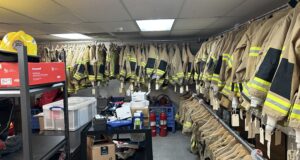Here’s a piece brother firefighter Charlie Hillman (Norwalk (OH) FD) wrote about a chimney fire last winter. He brings up several fireground basics that we all should remember. Pass it on!
On Wednesday, January 26, 2011 at 0850 hours the Willard Fire and Rescue department was dispatched to a chimney fire. The chimney fire was reported in a 1 ½ story wood-framed, single family dwelling, ranch style home. Upon arrival the supervisor initiated incident command and a performed a 360o size-up and radioed that there was heavy white/gray smoke issuing from the chimney. The homeowner had been attempting to clean the chimney with a homemade device that consisted of a long piece of copper tubing with a brush attached to the end of the tubing. The tubing was connected at the top of the chimney with a long piece of chain. The supervisor ordered the engine crew to ladder the roof to remove the burning brush from the inside of the chimney.
During the response to the chimney fire, the apparatus operator stated that he thought this home was in an area of a newer development. The entire jurisdiction is located in a rural community, so I thought this to be an interesting statement for the operator to make. I advised the rest of the engine crew that we should be on the lookout for lightweight construction characteristics that are commonly found in newer homes. Later, after the conclusion of the incident the engine crew went to the basement where the wood burner was located, and it was confirmed that this home was constructed of lightweight building materials. The highly dangerous, susceptible to collapse, wood I-beams were present as floor joists in this home. If the fire had been allowed to escape the confines of the wood burner, and spread into these floor joists; the consequences could have been deadly for the engine crew. However, the supervisor performed an extremely important aspect to keep the engine crew safe. The 360o size-up allows the fire officer to recognize an advanced fire condition in a basement that is attacking structural elements. Coupled with basic smoke reading principles, the fire officer can prevent a firefighter LODD due to a floor collapse. Hopefully, through the lessons learned in Colerain Township, fire officers can recognize these signs and not place firefighters in a precarious position.
Lightweight construction characteristics are not the focus of this article. Rather, an interesting scenario presented itself during the laddering operation of this roof. The transition from the ground ladder to the roof ladder was an obstacle that I had never encountered before. Normally, it is easy to make this transition, but the roof was steep and had a slight coat of ice on it that made this operation unique.
The roof was constructed of asphalt shingles and the rake of the roof was approximately 24 feet long. Due to the slight coat of ice, and the pitch of the roof, it was impossible to walk (without using a roof ladder) on this roof. It was difficult to deploy the roof ladder, because the ladder was only 16 feet long. Using a NY Halligan Hook, I extended my reach with the hook pushing the roof ladder (on its beam) up the roof and over the peak. The NY Halligan Hook proved itself a very useful tool during this operation. The neck of the hook (where the straight part of the hook and the curved part meet) fit perfectly into the spur of the roof ladder and I pushed it up and into place. Another difficulty that was encountered was the fact that the roof had a ridge vent extending the length of the roof, but terminating approximately 1 foot from the edge of the chimney. I had deployed the hooks of the roof ladder prior to sliding the ladder up the roof. During my first attempt to slide the roof ladder over the peak, the beam section would not go over the ridge vent, because the ridge vent was approximately 1 inch taller than the roof below it. Upon noticing that the ridge vent terminated prior to the chimney I moved the roof ladder down to the 1 foot opening and deployed the roof ladder. Once I slid the roof ladder over the peak of the roof the ladder still remained on the beam. Using the Halligan hook to extend my reach, I smacked the bottom rung of the ladder to a normal flat position. Next, was the transition from the ground ladder to the roof ladder. A slight ice coating was covering the shingles of the roof, making it a very dangerous proposition to move from the ground ladder to the roof ladder. Again, using the Halligan hook, I inserted the hook into the bottom rung of the roof ladder and used the hook to maintain my footing and stability as I transitioned from the ground ladder to the roof ladder. After I was onto the roof ladder I made my way to the chimney and removed the smoldering brush from the chimney which was completely extinguished by the crew below. Next, I descended the roof ladder, and again used the Halligan hook to maintain my footing and stability as I transitioned back to the ground ladder. Removing the roof ladder proved to be a difficult task. As I was now stationed back on the ground ladder, I had to push the roof ladder up and over the peak of the roof and back onto its beam. Pushing the ladder up was no problem, however, flipping the ladder onto its beam once it was over the peak was very difficult. To remove the ladder, a second firefighter came up the ground ladder behind me with a second longer hook, and pressed down on the opposite corner of the roof ladder that I was lifting up. This forced the roof ladder down onto its beam, and from there I used the hook to slowly guide the roof ladder down to where I could grab it and direct it to the crew waiting on the ground.
Using a small 25’ utility rope with a carabineer attached to a figure eight on a bight might have been a better option to assist with this operation. In conjunction with the hook I could have placed the rope onto the bottom rung of the roof ladder before it was deployed. Once the roof ladder was deployed, the rope could be used to help transition to the roof ladder. During the removal of the roof ladder the rope could have assisted with flipping the ladder onto its beam, making this a one firefighter operation.
Thankfully this incident occurred in a relatively non-emergency scenario. However, the next time the engine company could be inside waiting for the roof to be vented. I will be prepared to make this transition from the ground ladder to the roof ladder in a fraction of the time that it took during this incident. This will lead to increased efficiency on the fireground, now that this situation is in my mental slideshow of unique problems that we can face on the fireground.
 First Due Tackle Pass It On – Firefighter, Rescue & Extrication Training
First Due Tackle Pass It On – Firefighter, Rescue & Extrication Training





